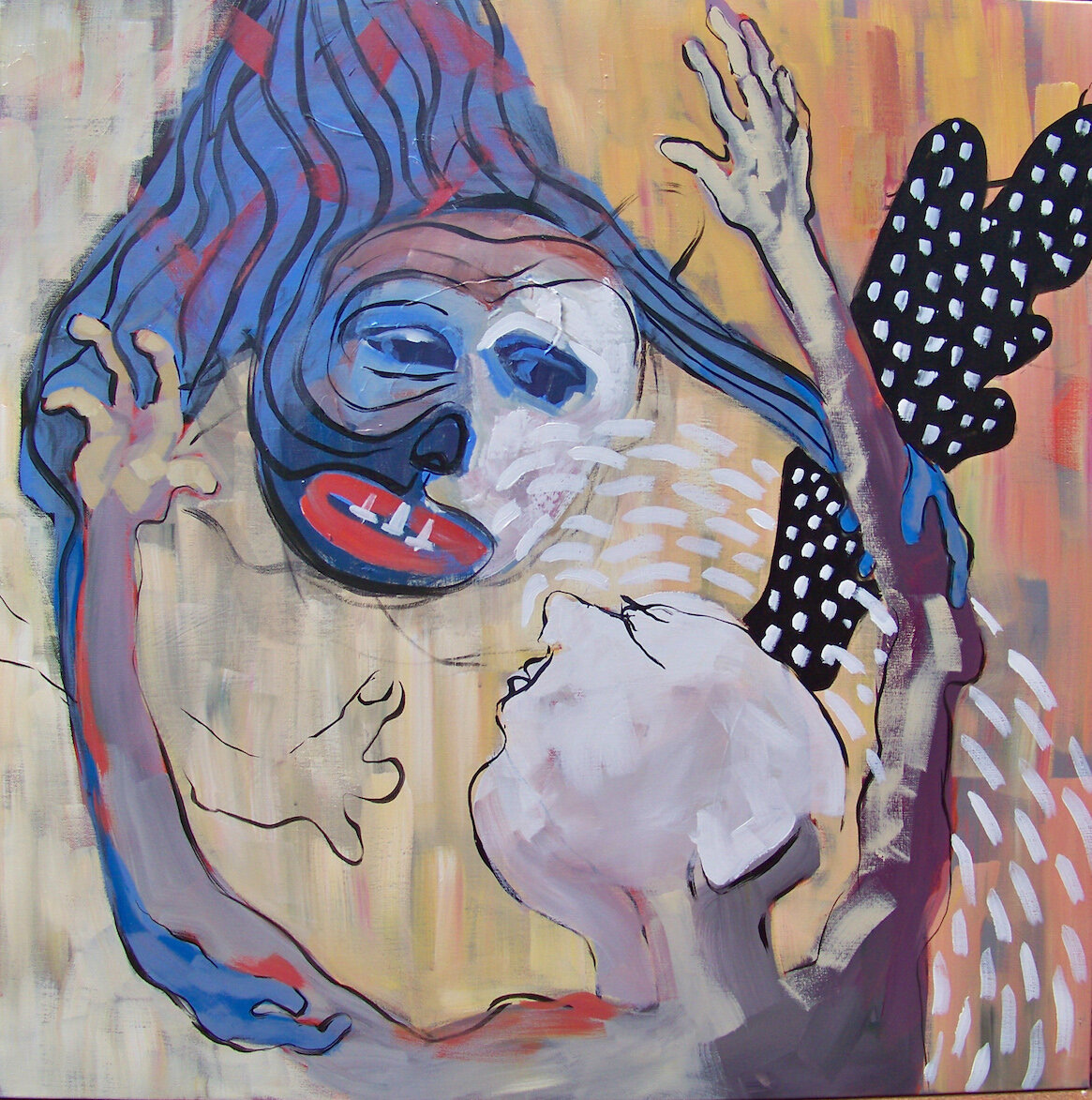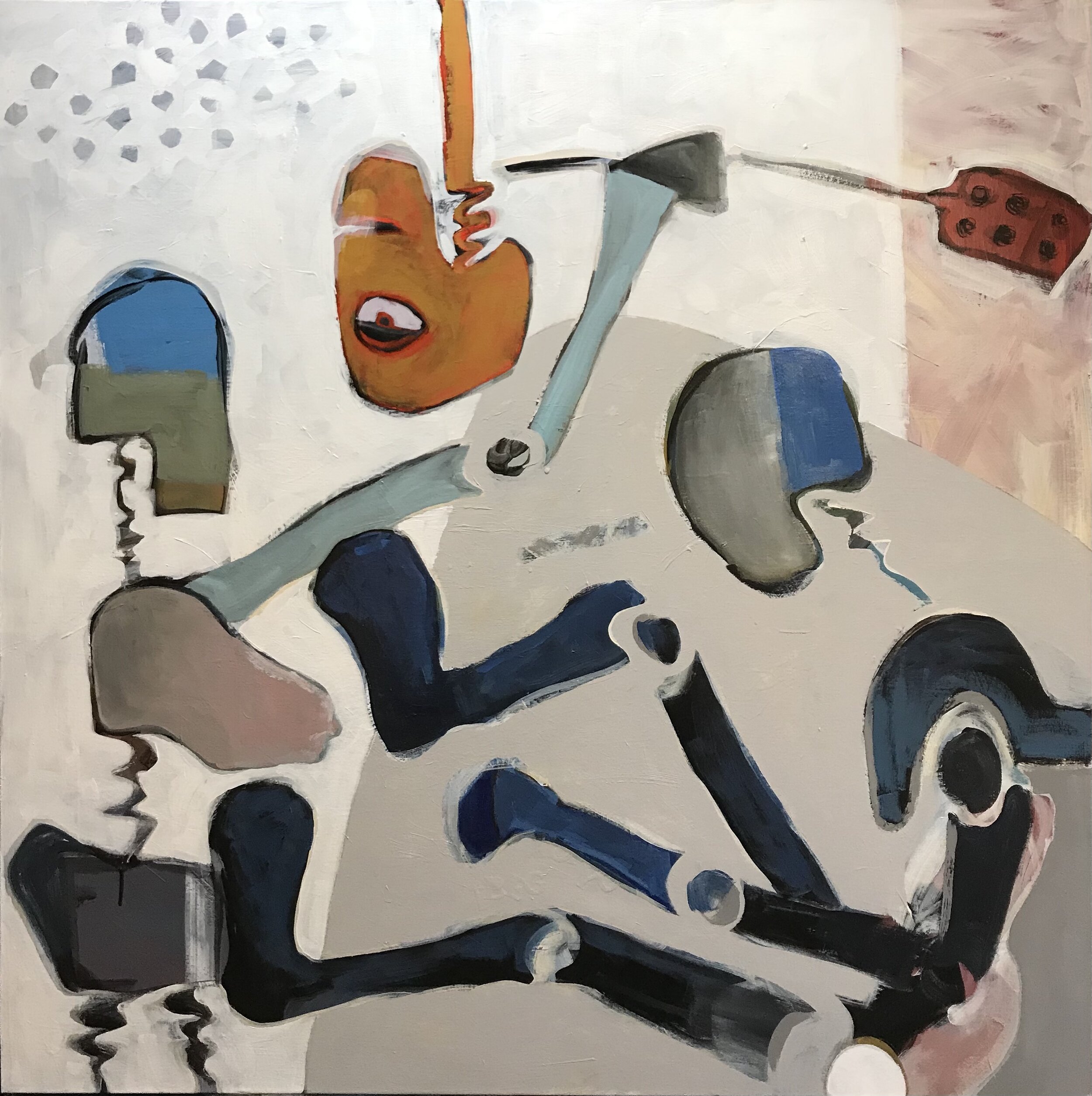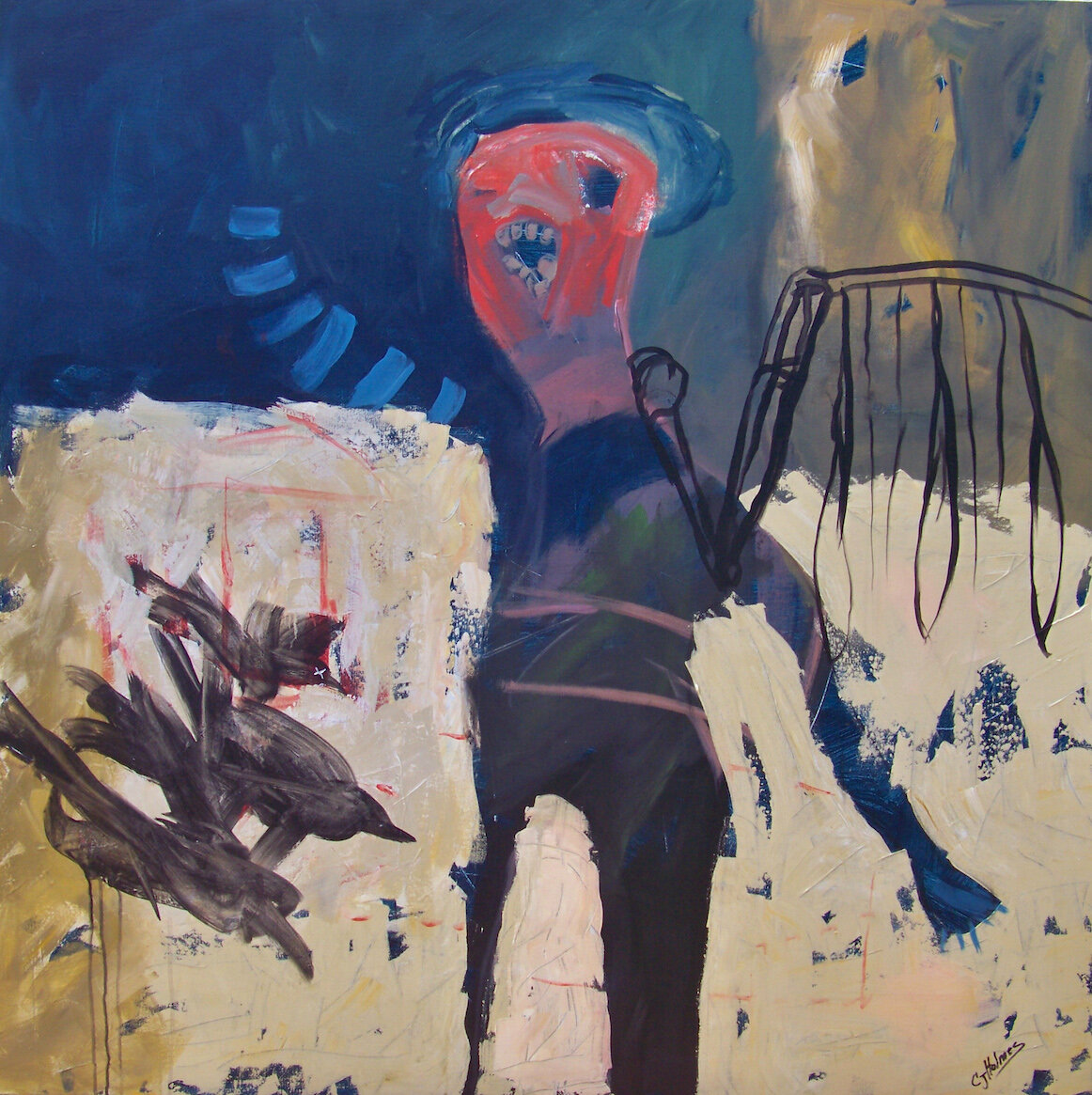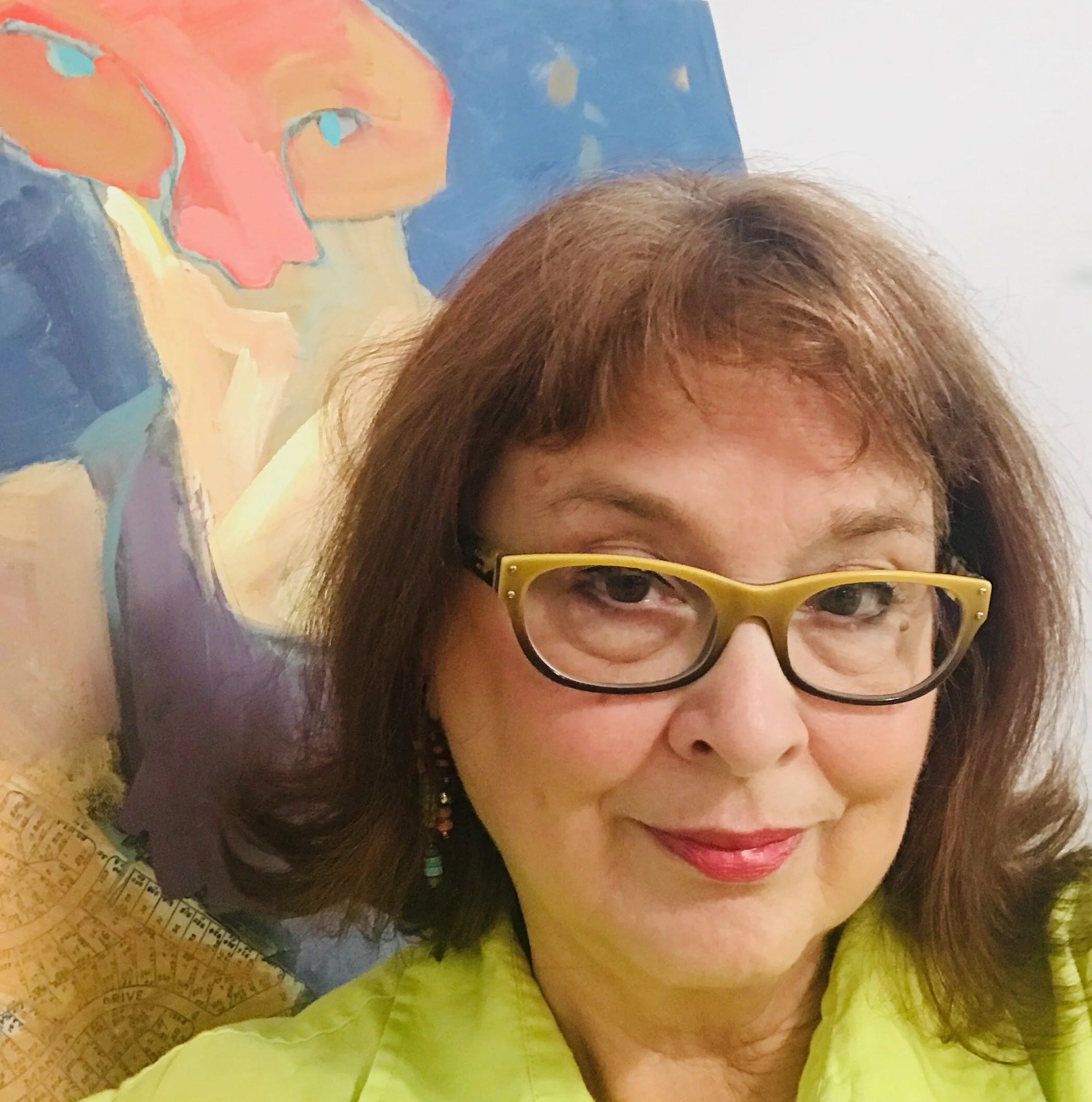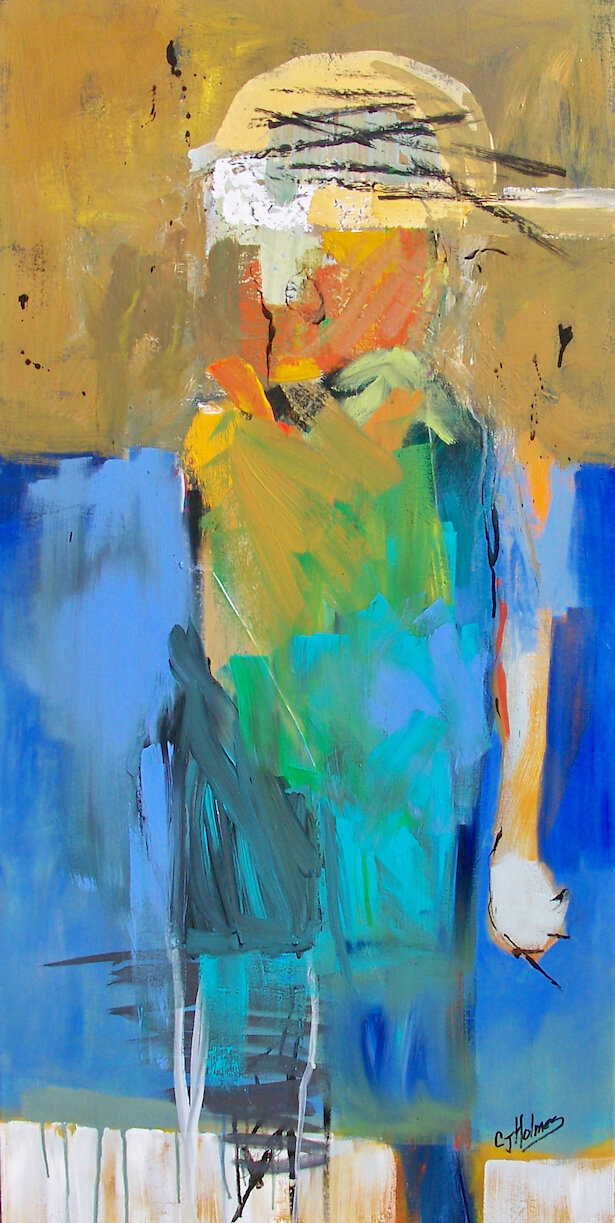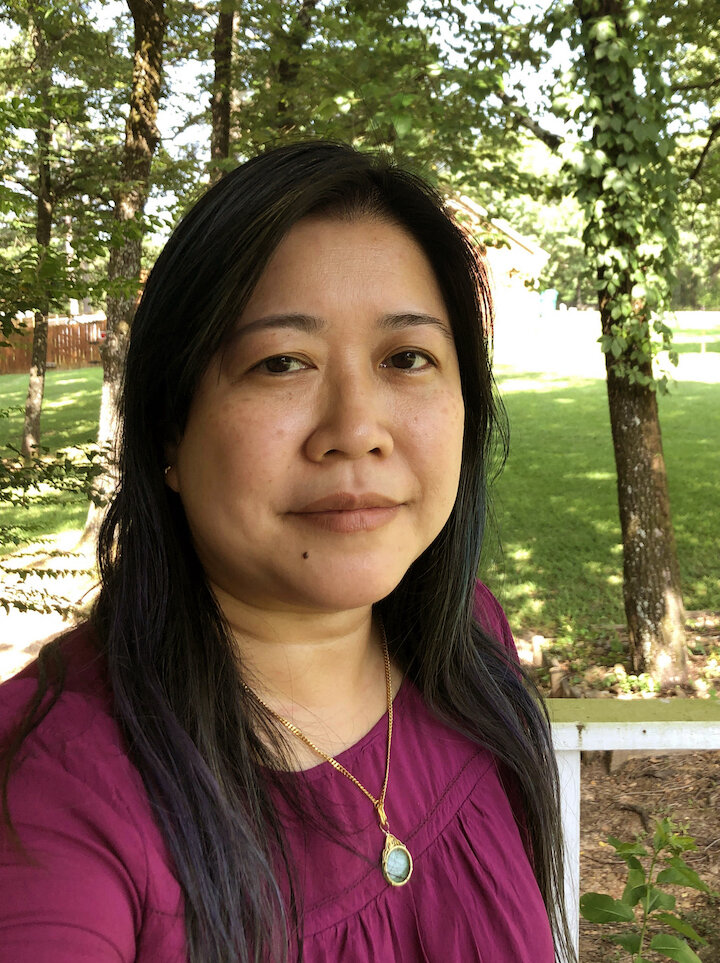Interview with artist Cindy Holmes
Cindy J. Holmes is an artist living and working in Texarkana. A self-described bookworm, she uses shapes and color – beautiful color – to express her love of the written word and the spoken words from her childhood on canvases that grab your attention – and maybe make you scratch your head - and she is OK with that. Cindy exhibits her work throughout the South especially in Arkansas and Texas and is widely collected. More of her work can be found at 1894 Gallery in Texarkana, M2 Gallery in Little Rock and at her website cindyjholmes.com.
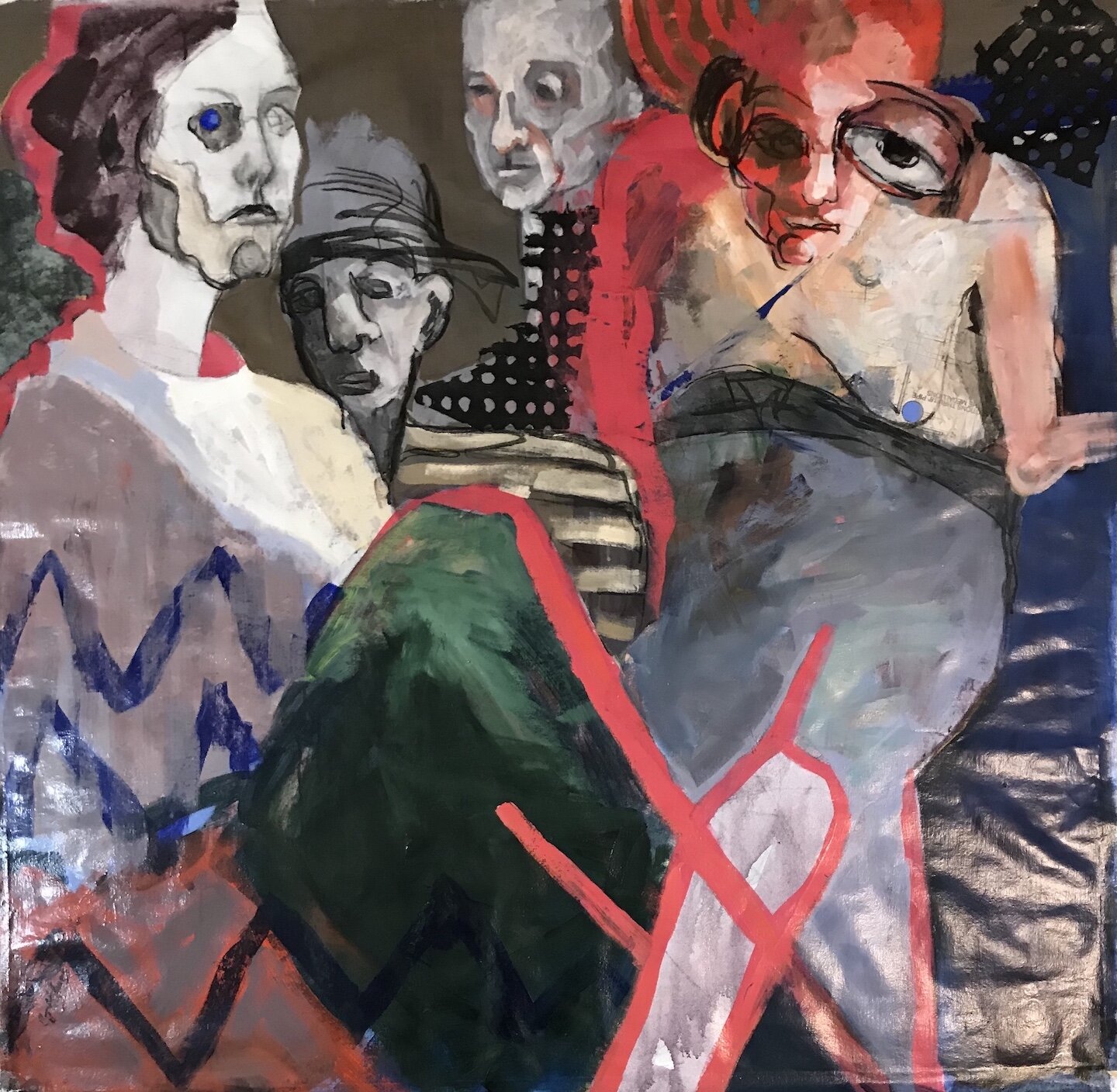
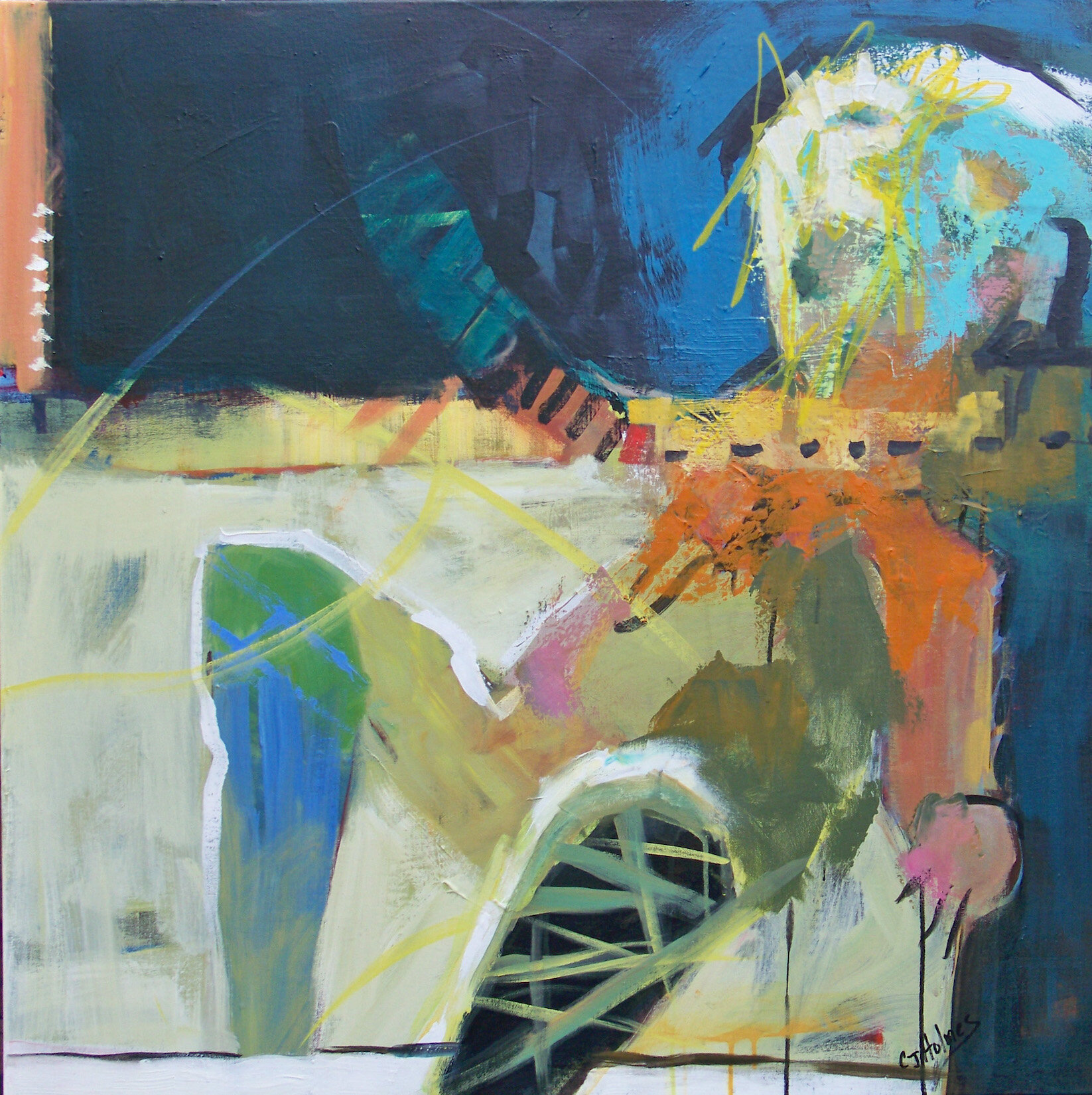
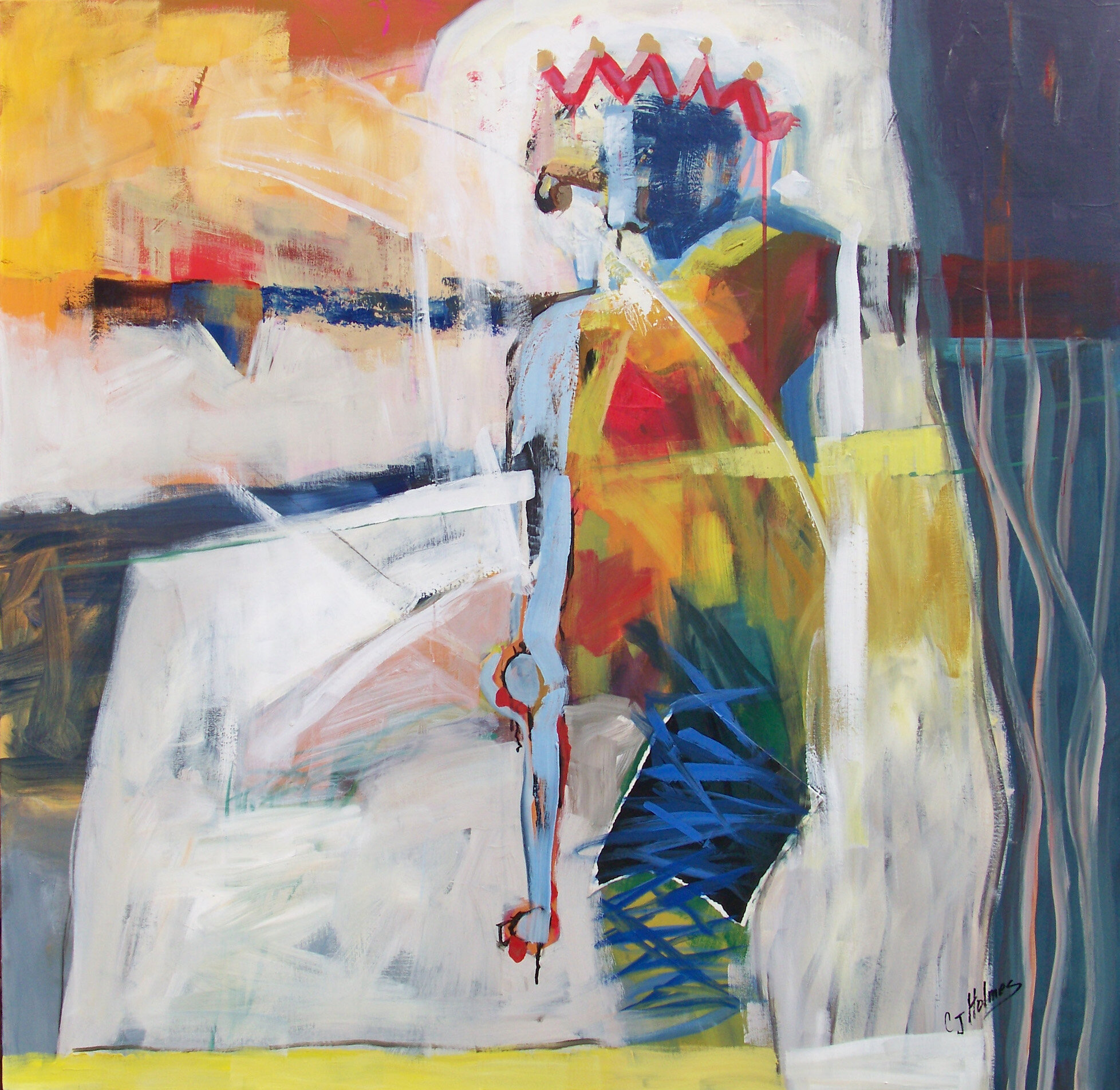
AAS: Cindy, you are not originally from Arkansas. How did you end up in Texarkana?
CH: I grew up in a small college town in Mississippi (Starkville) and attended MSU. All through my early school years I loved drawing and painting but being an ARTIST was never on the horizon. It was an unimaginable career for me. So, being a clueless 18 year away old, I fell into Social Work and Land Management. Don’t even know how that happened!
I got married after college and my husband’s work moved us around to several paper mills in the south. We lived in Natchez, Mississippi twice, Mobile, Alabama once and Texarkana twice. Our two children were born in Texarkana the first time we lived here, and they finished out their high school years when we were transferred back. So, Texarkana has been home for many years now.
AAS: When did you start painting?
CH: When my kids were in middle and high school, I started thinking about what I wanted to do when they left the nest. Rather naively, I signed up for a one-week painting workshop and immediately went out and bought brushes, paint and canvases. The instructor was a very loose impressionist yet had good teaching skills in the basics. Looking back, I realize how lucky I was! His teaching style suited my messiness with lines and color, and it was a week of heaven. I worked in oils and pastel for the next few years and made headway into national shows and work in the Pastel Journal magazine.
But life sometimes throws us a curveball and I became caregiver to parents for the next 18 years. This left me with occasional time to paint but no concentration. After everyone passed away, I took the time to reflect and decide what I wanted. I went to museums, looked at art whenever I could and finally decided. I wanted to change my medium to acrylic. I wanted my art to make people think. When I went to museums, the art that attracted me the most was something that made me laugh, that made me sad, that made me angry etc. I wanted to leave that museum and reflect on how the art made me feel, not just how it looked. So now when I paint, I know I’m saying something to myself. But, if it also says something to the viewer, I’ve achieved my goal.
“A thought, idea, word, conversation, book or poem can inspire. Then that might jog memories or a comparison within my own life to embellish the idea.”
AAS: Your work often has abstracted and surreal imagery. How would you define your style and esthetic?
The Eclipse, 36” x 36”, acrylic on canvas
CH: I honestly struggle with explaining what my style is. It has been mainly figurative for a number of years now, but those figures get pushed around until they either become abstracted or surrealistic. It really goes either way depending on my mood and how I want to tell the story.
I admire artists that can lay down a clean line, a perfect brushstroke but I think I just enjoy being a bit messy. I’ve learned to embrace my scribbled lines and messy brushstrokes. My disorganized thoughts must influence my hand! But maybe those disorganized thoughts that jump from one unconnected idea to another are really what helps me build my painting. As I paint, I get to choose how the figures and colors can display the emotion or storyline but often things can change and I’ll go in a completely different direction.
That’s what I love about acrylic paint. It gives me the ability to paint over, change and layer. It’s a bit like life. Nothing is ever certain. Whatever I do, I think you’ll always recognize my hand in the brushstrokes while using my figures as mannequins in my thought process.
AAS: I first met you and saw your work in 2017 in a show at Matt McLeod’s gallery in Little Rock. Worm Weather is honestly one our favorite pieces in our collection. It’s quirky, colorful and has a great story behind it. Would you talk about the inspiration for that piece and what inspires your work in general?
Worm Weather, 48” x 48”, acrylic on canvas
CH: I’m so glad y’all love Worm Weather! It was the first painting I did in my Weather Monger series. I’ve found that if I give myself a stated direction, paintings will flow along on a variation of the theme. Just watching the weather at night gave me all these lovely words to catch my imagination. Flash flood warning, tornado warning, heat index, hazy and so on. But you’ll never hear them say worm weather is coming! That brings back memories of a sci-fi book I once read. It was about how a yellow sky with a greeny glow indicated the aliens were coming (yes, I’m a sci-fi addict). So now, I always say worm weather is here when our atmosphere has a yellow tinge during tornado season. And the funny little propellers on their heads? My father gave me a beanie cap with propellers. I was the envy of all the second graders. This is how my mind works before and during a painting. A thought, idea, word, conversation, book or poem can inspire. Then that might jog memories or a comparison within my own life to embellish the idea. I only did 4 or 5 paintings in the Weather Mongers series, but I still hold the thought that I’m not finished. Maybe when the time is right, I’ll start up again.
AAS: Your work has a balance of humor and sometimes even repulsion but can (sometimes) be tender. I am thinking about Family Portrait and the way their fingers touch.
The Family Portrait, 48” x 48”, acrylic on canvas
CH: If people see a large grouping of my paintings, they will start to notice that many will show a bit of humor or darkness (repulsion as you say). Because, honestly, my paintings are about me. It’s just a visual walk through my world expressing bits and pieces. And the viewer really doesn’t have to know anything about me! I get all excited if they make a connection to a painting from their own experiences. The Family Portrait started out very differently - more like a static and surreal Olan Mills photo. I think that’s where painting experience comes into play. You’ve learned when to change something when the technique is good but the expression not so much. I was much happier with the movement and connection between the bodies after a lot of repainting!
The Invisible Suit, 36” x 36”, acrylic on canvas
AAS: The faces in some of your paintings have a wonderful longing look. Would you talk about The Invisible Suit and Letting Your Head Rule?
CH: It’s funny you should bring up those two paintings. I used the same model for both. Before Covid, I would go to life drawing to sketch, and she was always my favorite – very androgynous and completely at ease with her body. I’ve indicated her as male or female in a number of paintings. She also had a very mobile face and would let me take photos on her break while she was smoking and talking. I like to think that some of the paintings that feature her face, exhibit a bit of her personality.
Letting Your Head Rule Your Heart Or Is It Vice Versa, 60” x 60”, acrylic on canvas
AAS: I have to ask about Down The Rabbit Hole. It is such a fun piece. What inspired it?
Down the Rabbit Hole, 48” x 48”, acrylic mixed media on canvas
CH: Down the Rabbit Hole is fun Texarkana history. He was a six-foot plaster rabbit that sat on the side of the road I believe from the 1940’s-late 90’s before vandals took a baseball bat to him. At one time he was even featured on Texarkana postcards. I first saw him sitting in front of a pawn shop wearing a saddle and people would stop, set a kid in the saddle and take photos. So glad I took my own photos of him, but it was a number of years before I pulled them out to incorporate into a painting. This one was all word association for me - rabbit, rabbit hole, Alice and maybe she needed a gun to protect herself. In the end, Alice became a gun toting diva ballerina.
AAS: I am almost afraid to ask about Dreams of Revenge (Ha), but I find it a fascinating and terrific painting.
Dreams of Revenge, 48” x 48”, acrylic on canvas
CH: Oh this is a good one - one of my dark paintings. I hate to say this, but I have a hard time connecting to poetry even though I love books. But every once in a while, I’ll make an effort to find some poetry that I like, and it always seems to be dark. This was a phrase from a Sylvia Plath poem. And just that phrase brought imagery to my mind about how revenge will eat at you until there’s nothing left. Painting was very intense and there was no second guessing about “is this working?”, “should I change this or that?” Love it when a plan falls together! Also, I just found out that it will be going to a show in Dallas.
AAS: A lot of your work is inspired by things from your childhood too. Would you talk about your series You could throw a cat between your legs and other stories…? Love the title!
CH: This group of three paintings might not look it but was brought on by an excess of nostalgia. My mother’s side of the family was a clan of chubs and my father’s side were skinny sticks. Mother’s side could be a bit proper so, of course I loved visiting my father’s family. All the men sat around an outside fire at night while smoking, dipping snuff, talking, and trading opinions. And they allowed a gang of us kids to drive them crazy. This was the first time I heard someone wonder if there were people beyond the stars (and they were sheep farmers!). This was also the first time I heard my father derogatorily describe a skinny woman as “you could throw a cat between her legs”! He obviously liked chubby women as he married my mother. So, all that nostalgia about the stories and talk around a night time fire is what instigated this grouping.
You Could Throw A Cat Between Her Legs And Other Stories… II, 60” x 20”, acrylic on canvas
You Could Throw A Cat Between Her Legs And Other Stories… III, 60” x 20”, acrylic on canvas
AAS: In creating paintings that come from your imagination, have you learned anything about yourself?
CH: I’ve learned that I don’t really paint from my imagination! My imagination comes to the fore in how I visually interpret what I know and feel. I think color has been a big influencer for me. Sometimes it leads me down the wrong path and I have to change it until it feels right. If I have to mix 10 shades of blue before I get the right one, then so be it! For me, the right color says the right thing, and emits the right emotion to affect the viewer. I’ve also learned that I don’t regret changing from landscapes to the surreal and abstracted. Maybe my mind games keep me entertained and challenged!
AAS: What do you hope someone sees when they look at your paintings?
CH: I can only hope that someone sees a little bit of themselves in my paintings. If they identify an emotion in one of my paintings, I’m happy. Even better if they connected to the painting because it raised their own emotions. In the end, I don’t care if I have a pretty painting. I just want someone to ask, “What’s happening there?” One of my favorite examples of that was a woman who told me all her friends were going to think she was weird for buying a painting I did. Then she laughed and said, “We must be two peas in a pod as you must have been just as weird to paint it!” I still smile when I think about that.
As late in life as I started my painting career, I’m very fortunate to be shown along with other wonderful artists in M2 Gallery here in Little Rock and 1894 Gallery in Texarkana. Even though I don’t always get to meet my collectors, they range across the United States from California to Florida, in one corporation and even in England. I like to pinch myself over the England one. At least my painting got to go even if I didn’t!
